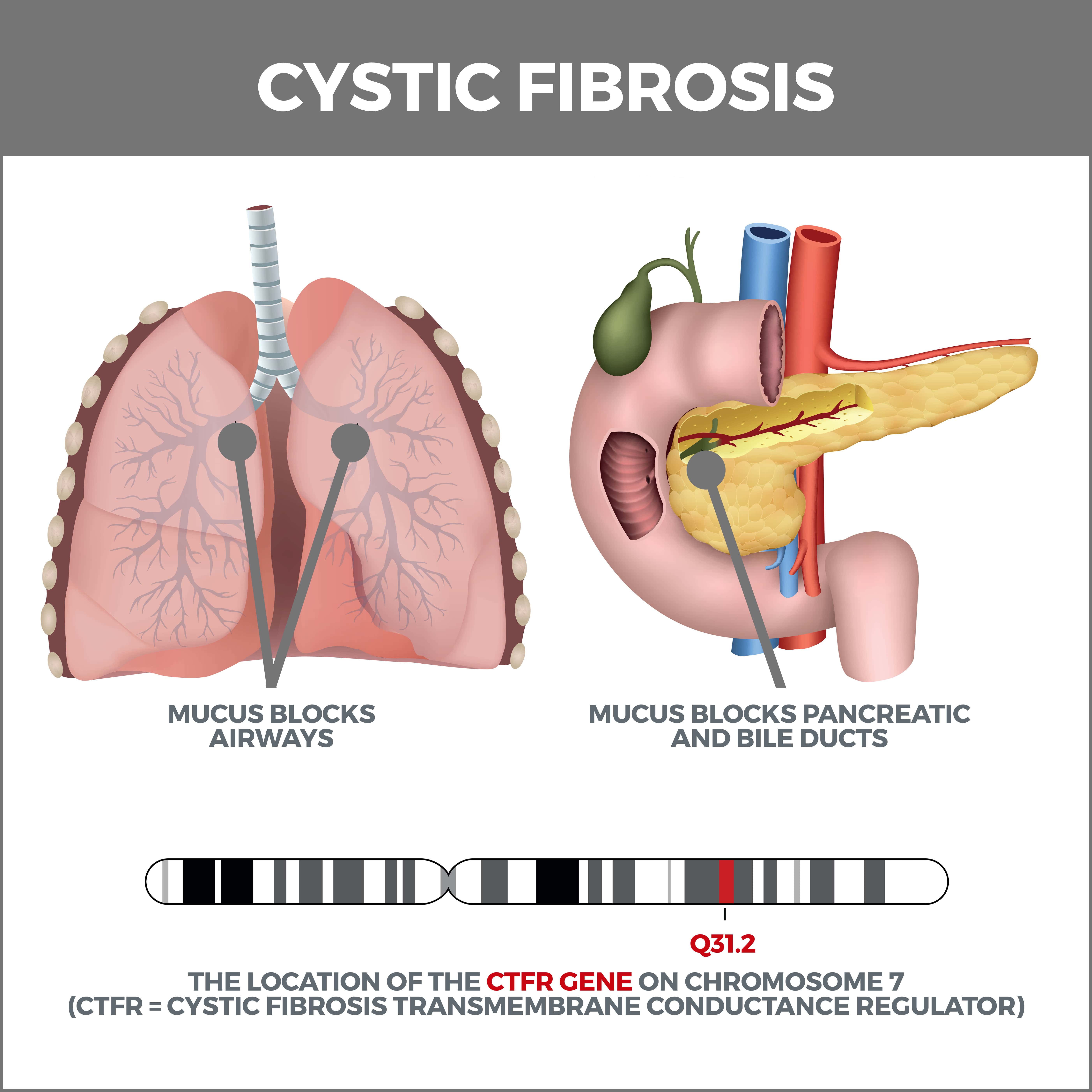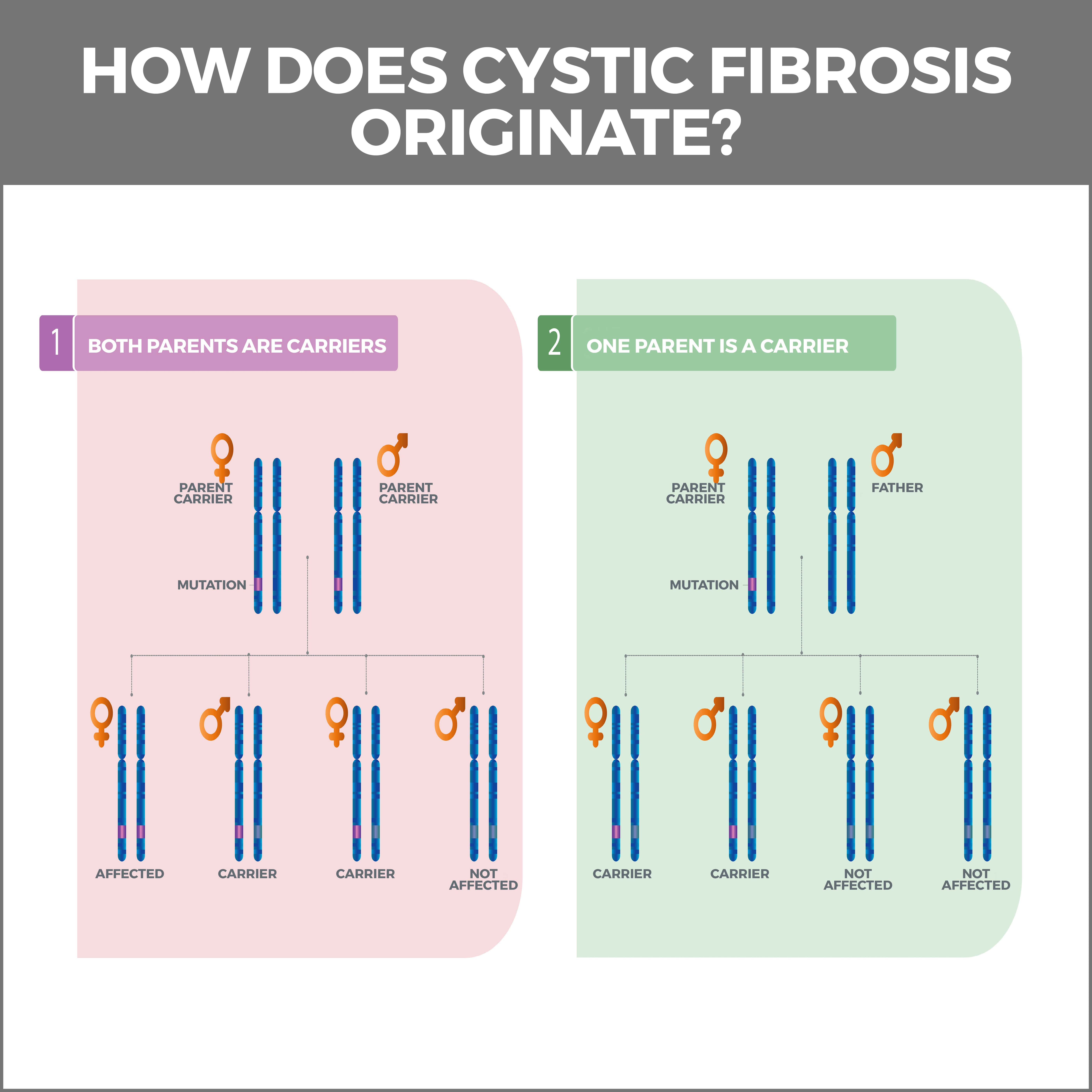Cystic Fibrosis
The body is an amazing machine that carries out millions of daily processes, such as breathing, blood circulation, digestion, and movement. Each of these processes depends on the activities of organs such as the brain and heart. Unfortunately, diseases and chronic conditions plague us every day. You can reduce your risk of suffering from one of these conditions by understanding the way these diseases work.
Genetic disorders are health conditions caused by defects in a person’s genes. No one knows how they develop. Symptoms vary, but most genetic disorders disrupt the growth or development of the embryo, the organs, or other body parts. The disorders do not spread through contact with an infected person. Most cannot be cured.
What is Cystic Fibrosis?
Cystic Fibrosis, or CF, is a chronic genetic disorder. People with CF have thick, sticky mucus in their lungs, pancreas, and other organs. This makes it hard to breathe and digest food. The illness is caused by a mutation in the cystic fibrosis transmembrane conductance regulator gene (CFTR gene) located on chromosome 7. Scientists have identified many different mutations. Each mutation results in other effects on the body’s ability to function correctly. The specific mutation a person has or has had determines how the disease affects each individual.

The CFTR gene controls the movement of salt and water in and out of cells in your lungs, pancreas, and other organs. It carries out this function by helping regulate chloride ions, which carrying electricals current in your cells. In people with CF, the gene does not work correctly. As a result, cells that line the airways and pancreas do not make enough chloride ions to move food and bodily fluids through the body normally. Mucus buildup in the lungs, pancreas, and other organs, causes lung infections such as pneumonia and digestive problems.
The Disease in Figures
- 70,000 to 100,000 children and adults suffer from the disease worldwide.
- About 30,000 people in the United States have cystic fibrosis.
- 1,000 new cases per year.
- About 75 percent of new diagnoses happen before age 2.
- The disease affects about 1 in 2,500 to 3,500 white newborns.
- Since 2010, it has been mandatory for all doctors in the United States to screen newborns for cystic fibrosis.
- Cystic fibrosis is not as common in other ethnic groups. It affects about 1 in 17,000 African Americans and 1 in 100,000 Asian Americans.
- 2 years is the average time for a diagnosis.
Signs and Symptoms
Cystic fibrosis affects the body in different ways. Symptoms usually develop by age two and worsen as the child grows older. The severity of symptoms ranges from mild to severe.
- Chronic Lung Disease – People with CF have difficulty breathing and are at risk for lung infections. The thick mucus in the lungs makes it difficult to take in air. This makes it hard to breathe and forces the body to work harder for less oxygen and nutrients than healthy people get.
- Diarrhea – Sticky mucus and infection in the small intestines can slow down the movement of food and waste. This causes frequent, often severe, diarrhea.
- Dry Skin – The sweat glands in people with CF do not work well, so they have dry skin. The sweat is salty and may smell bad. Soap may not help with the odor.
Other signs and symptoms include short stature, recurring ear and sinus infections, excess body fat, unusual facial features such as a blind eye, cleft lip and palate, poor growth and development, faintness or dizziness at times, and delayed puberty.

Who’s at risk for cystic fibrosis?
Cystic fibrosis can affect individuals of any ethnicity and geographic region. The only identified risk factors are race and genetics. Among Caucasians, cystic fibrosis is the most common autosomal recessive disorder, meaning both parents must be carriers of the gene for their child to develop the condition.
Johns Hopkins reports that certain ethnicities are more likely to carry the faulty gene. The risk of having the gene is:
- 1 in 29 for Caucasians.
- 1 in 46 for Hispanics.
- 1 in 65 for African Americans.
- 1 in 90 for Asians.
The risk of having a child born with cystic fibrosis is:
- 1 in 2,500 to 3,500 for Caucasians.
- 1 in 4,000 to 10,000 for Hispanics.
- 1 in 15,000 to 20,000 for African Americans.
- 1 in 100,000 for Asians.
There’s no risk unless both parents carry the defective gene. In the United States, about 1 in 31 people are carriers of the gene. Most people don’t even know it.
How Is CF Diagnosed?
Diagnosis is based on symptoms and family history. An accurate diagnosis takes a genetic analysis of the patient’s DNA that can detect the presence or absence of a particular gene. It also determines what other genes might be affected by the disease. The genetic analysis involves blood tests, physical exams, and checking for family histories.
A sweat test is one of the diagnostic tools used to detect CF. This is an analysis of the patient’s sweat to determine if there is a significant amount of salt in it.
Your doctor will start your diagnosis by asking about your medical history before moving on to testing and physical exams. The doctor will need to know if any family members have the disease. They will also ask if you have any disease symptoms, such as frequent lung infections, digestive problems, and diarrhea. Your doctor will order a genetic test to rule out CF if you have a history of these health issues and family members with cystic fibrosis.

Effects of CF on the Quality of Life
The disease can make it very difficult to live a normal life compared to healthy people. People with CF have trouble with things such as standing still for long periods, walking, talking, and communicating. People with the disease can suffer from digestive issues such as frequent and painful bowel movements, difficulty getting a good night’s sleep, and pancreatic problems such as diarrhea or pancreatitis.
It can also cause children to be overweight and fail to grow normally at an appropriate age. Many people may need a transplant in the later stages of the disease. Some may even need to have their entire digestive system replaced as it deteriorates with time. Advances in medicine and treatment have allowed some patients to live into their 50s and beyond in relatively good health.
Treatment
There is no cure for cystic fibrosis yet. But treatment can help patients manage their symptoms. People with CF must learn to care for themselves to live as long as possible. This includes taking medicine to control the symptoms and having regular check-ups at a hospital or clinic. Cystic fibrosis is usually diagnosed in newborn screening tests conducted soon after birth.
Treatments vary with each person, but they focus on controlling lung infections and digestive problems. This includes maintaining a good weight, eating a healthy diet, and taking medicines that help digestion and lung function.
Treatments can include antibiotics to fight lung infections or other medications to improve the movement of salt and fluids through the lungs and intestinal system, as well as nutritional supplements. The doctors may use a special breathing device to help people inhale and exhale more easily if their symptoms worsen. They also use pancreatectomy tubes. These are tiny tubes that go into the stomach to keep digestive juices flowing properly. Treatment helps patients live longer, stronger lives.

Some patients may need more surgery to improve their lungs, pancreas, or digestive system. Surgery can help with bowel problems, repair breathing tubes, or correct a cleft lip and palate. Gastroenterology is a specialty that deals with the digestive system, so a gastroenterologist will monitor for any leakage of digestive juices into the lungs. If this liquid is discovered in the lungs, they will find an effective way to help prevent complications caused by the fluid buildup. Despite these advances, scientists are still working to find a cure. Researchers are exploring new possibilities, such as stem cell research and gene therapy.
Contact Us
Cystic fibrosis is a life-threatening illness. Early detection and treatment can improve the quality of life for patients. Scientists are constantly working on developing better treatments, and a cure may be within reach in the future. Visit a gastroenterologist to learn more about the disease and treatments available.
Call us today! The team of professionals at GastroMD looks forward to working with you. We are one of the leading gastroenterology practices in the Tampa Bay area. We perform a host of diagnostic procedures using state-of-the-art equipment in a friendly, comfortable, and inviting atmosphere where patient care is always a top priority!



